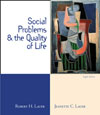CHAPTER 6 Violence What Is Violence? (pp. 182-185) Violence can occur between two or more individuals as interpersonal violence,
or it can involve identifiable groups in society and erupt as intergroup violence.
Clashes between racial, religious, or political groups are examples of the latter.
Much interpersonal violence involves acquaintances, while intergroup violence
is more apt to involve people who are strangers prior to confrontation. Studies
reveal a considerable amount of violence throughout American history, fluctuating
from one period to another, with the reasons changing. Today virtually all Americans,
if not directly exposed to violence, are indirectly exposed to it through the
mass media. In the 1990s, attention has focused on violence at the workplace.
Children experience a great deal of violence, and much of this occurs in the
school setting. The violence that occurs in intimate relationships dramatizes
the extent to which we are a violent society; over thirteen percent of all violent
victimizations occurs between intimates. There is also a great deal of intergroup
violence. The tragic bombing incident in Oklahoma City punctuates a new form
of this type of violence, but this was not the first encounter between the federal
government and militia groups. Violence and the Quality of Life (pp. 186-188) The meaning of violence must be totaled in terms of human destruction, injury,
psychological disruption or trauma, dehumanization, economic cost, and seductive
self-destruction-a term referring to self-defeat resulting from the use of violence
in order to obtain victory. Posttraumatic stress disorder is another possible
outcome for people in abusive situations. Contributing Factors (pp. 188-202) Although some people have thought that violence is linked with a human need
to be aggressive, recent observers have argued for other factors, including
frustration, a subculture of violence, cultural values and patterns, political
processes, social inequality, and social psychological reasons such as legitimating
attitudes or rationalizations. The politics of gun control must also be considered.
A frequent explanation for violence involves the notion of relative deprivation,
the sense of deprivation in relation to some standard. This theory holds that
people are not unhappy or do not revolt simply because they are poor; rather,
they become anguished and rebellious when their expectations exceed their objective
conditions. Although people may be better off in terms of their past, they are
worse off in terms of their expectations or aspirations. The notion of a subculture
of violence must also be taken into account. Two values that support official
violence or violence used for social control are retributiveness and self-defense.
The mass media expose us to an enormous amount of violence. What Is to Be Done? (pp. 202-203) The authors express their own position by advocating (a) a change in the norms
surrounding our society's attitudes toward violence; (b) gun control measures;
(c) reduced presentation of violence in the mass media; and (d) reduction of
social inequality in our society. The Violence of Rape (pp. 203-204) Our legal code distinguishes between two kinds of rape, forcible and statutory,
the latter referring to consensual sexual intercourse between a male over the
age of consent with a female below legal consent age. The concern in this chapter
is with forcible rape, which is one of the seven major felonies in the FBI Crime
Index. It is defined as actual or attempted sexual intercourse through the use
of force or the threat of force. It is a form of interpersonal violence rather
than an expression of sexual passion. According to the FBI's Uniform Crime Reports,
there were 105,000 cases of forcible rape in 1993. Victimization studies now
estimate that about 500,000 women are raped each year. A victim is likely to
be young and in the lower-socioeconomic stratum. Rape and the Quality of Life (pp. 204-209) At least 85 percent of rape victims wind up physically abused; perhaps all
are hurt emotionally. The authors discuss these victims in terms of physical
and emotional consequences. Rape is a highly traumatic experience and the fear
of rape probably causes uneasiness in most women at some time. The victims of
rape experience severe emotional trauma. The rape victim may also suffer physical
harm; the force and brutality so commonly involved in rapes leads us to conclude
that we are dealing with an act of violence rather than of sexual passion. Contributing Factors (pp. 209-215) Of particular concern to the authors are the factors that tend to encourage
offenders and oppress victims. Certain traditional norms about sex roles are
factors in some rape cases; in general, the more that men are integrated into
a culture where the norms support male dominance and superiority, the more likely
they are to find rape acceptable. Negative family experiences can foster the
development of a rapist. Many people accept certain myths about rape. The mass
media play an important role in perpetuating these myths. Macho values also
seem to be a factor in the tolerance of, and proneness to, rape. What Is to Be Done? (pp. 215-216) The authors suggest four lines of attack in dealing with this social problem:
(a) programs of prevention need to be established; (b) sex-role norms, legal
processes, and certain attitudes must be modified; (c) rapists need treatment,
not simply punishment; (d) we must provide genuine help for the victims and
the potential victims of rape through such means as rape crisis centers and
police rape teams. Ending the chapter on an optimistic note, the authors believe
that more people are realizing that rape victims should be helped and not oppressed
further by humiliating encounters with either the public or the authorities. | 


 2002 McGraw-Hill Higher Education
2002 McGraw-Hill Higher Education